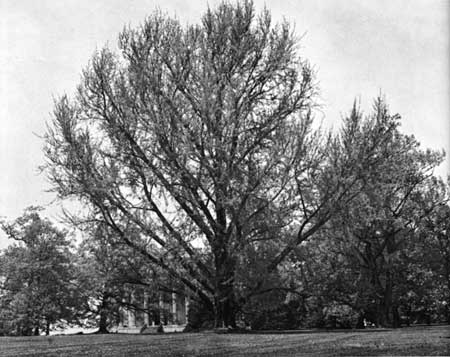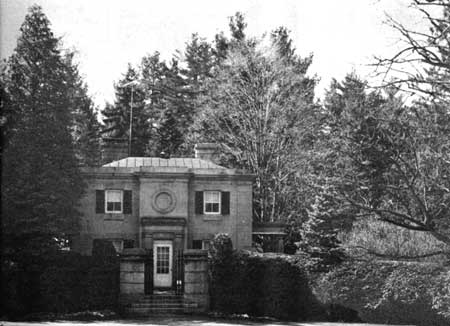|
VANDERBILT MANSION National Historic Site |
 |

Ginkgo, or Chinese maidenhair-tree.
Description of the Grounds
Trees. For almost two centuries these grounds have been part of country estates owned by influential and wealthy men. The magnificent specimen trees which they planted here may be ranked as a feature of interest second only to the mansion itself. Approximately two score species and varieties are represented, many of them from Europe and Asia.
Trees of foreign origin include European ash, European beech, English elm, Norway spruce, Norway maple, the red-leaved Japanese maple, and a ginkgo, or Chinese maidenhair-tree. This ginkgo is among the largest of that species in the United States.
Among the native American trees represented are sugar maple, flowering dogwood, eastern hemlock, Kentucky coffeetree, white oak, black oak, eastern white pine, and blue spruce. Other fine examples of their kind include large beeches, bur oak, and a great cucumber magnolia. Many of these trees are labeled.
Pavilion. Designed by McKim, Mead, and White, this building was erected by Norcross Brothers in 66 working days, September 8 to November 24, 1895, on the site of the old Langdon carriage house. Cost of the structure probably exceeded $50,000. The pavilion was used by the Vanderbilts during the construction and furnishing of the mansion, and, later, on weekends in the winter season when they came to Hyde Park for winter sports. The pavilion was also used to house the overflow of guests from the mansion.
The pavilion represents an adaption of classic Greek architecture. Certain liberties have been taken in the interest of functional arrangement, such as the placement of window openings and modifications necessary for the captain's walk on the roof. The result is a pleasing combination of classic form and informal detail.
Gardener's Cottage and Tool House. These two buildings, located south of the mansion are the only structures on the estate that antedate the Vanderbilt era. Walter Langdon had them built in 1875 according to the design of John H. Sturgis and Charles Brigham, architects of Boston, Mass. Neither building is open to the public.
The Italian Gardens. These gardens, which lay south of the mansion, may possibly date back as far as Dr. Samuel Bard's era in 1795. They certainly existed in 1830 as a part of Dr. David Hosack's estate, and the later owner, Walter Langdon, continued to maintain them. Landscape architect James L. Greenleaf radically revised and enlarged the gardens in 1902-3 for Frederick Vanderbilt.
The gardens thus represent several periods of development. They were divided into three units: The greenhouse gardens, the cherry walk and pool gardens, and the rose garden. The first of these consisted of three separate parterre gardens within a rectangle framed on the west by the rose and palm houses and on the north by the toolhouse, carnation house, and gardener's cottage. The cherry walk and pool gardens. were located east of this group at a lower level, and progressed from the pergola to the garden house. The rose garden, still further east, had two terraces and contained panel beds.
North Drive and North (Exit) Gate. The land north of the pavilion was added to the estate in 1905. From the north drive are unsurpassed views of the Hudson, the Shawangunk Range to the west, and the Catskill Mountains to the north. The north gate was erected in 1906. Directly opposite, on the east side of the Albany Post Road, are the Vanderbilt barns, built in 1901. This part of the estate is now in private ownership.

Main gatehouse.
Main (Entrance) Gate and Gatehouse. These structures date from 1898 and again represent the combination of McKim, Mead, and White-Norcross Brothers. The gatehouse is still used as a residence and is closed to the public.
White Bridge. This bridge over Crum Elbow Creek was designed and constructed in 1897 by the New York City engineering firm of W. T. Hiscox and Company. A Melan arch bridge, it was one of the first steel and concrete bridges in the United States.

River gatehouse.
River Gate and Gatehouse. The carriage road and Crum Elbow Creek proceed southward, ending near the Hyde Park railroad station at the Hudson River. Near this point is the river gate and gate lodge. These were designed by McKim, Mead, and White, and constructed by Norcross Brothers in 1898. The gatehouse is still used as a residence and is closed to the public.
The Coach House. Located on the river hill, a short distance east (or above) the river gate, is the coach house. It was designed by the New York City architect, R. H. Robertson, and erected by Norcross Brothers in 1897. In 1910, R. H. Robertson altered the coach house so it could also be used as a garage.

|

|
|
Last Modified: Mon, Mar 4 2002 10:00:00 pm PDT |


